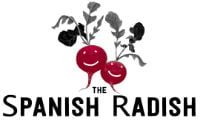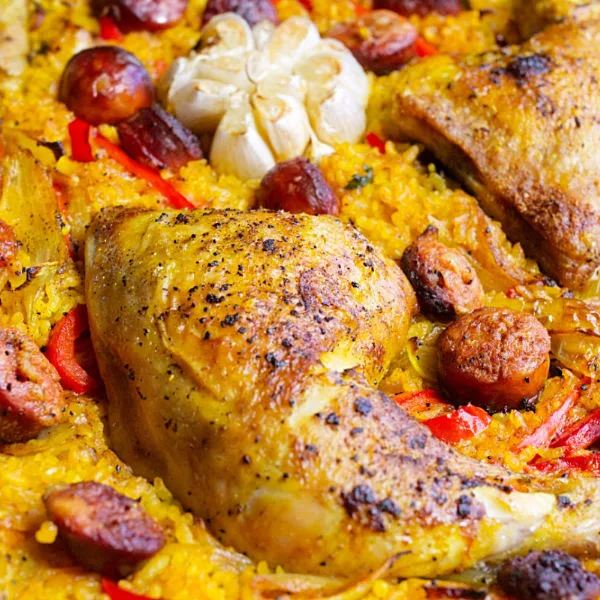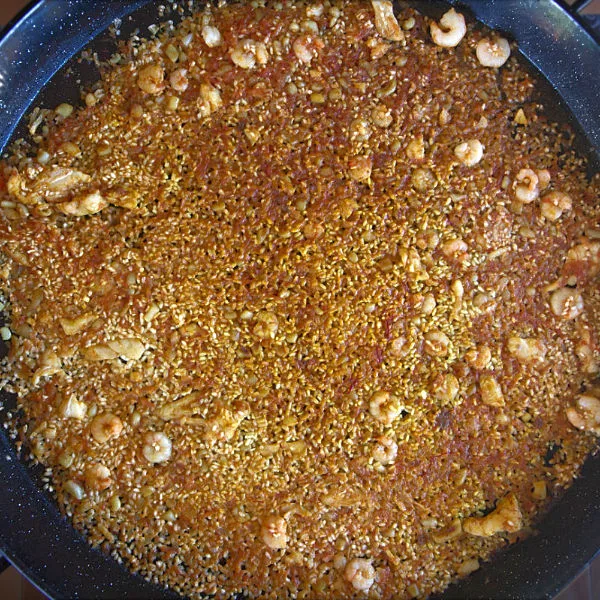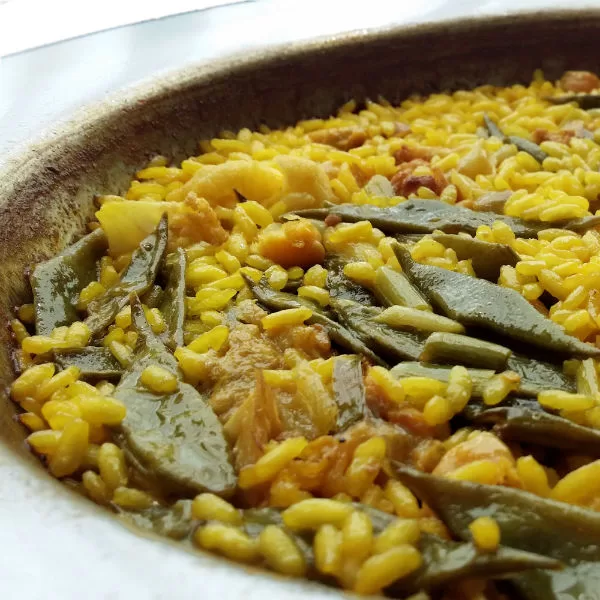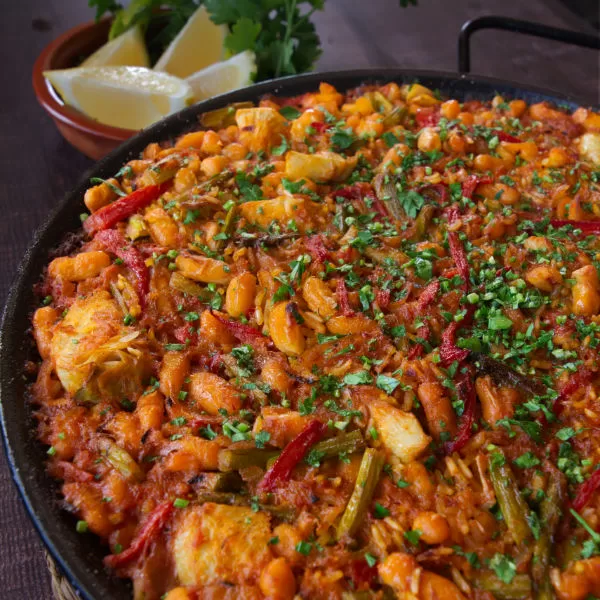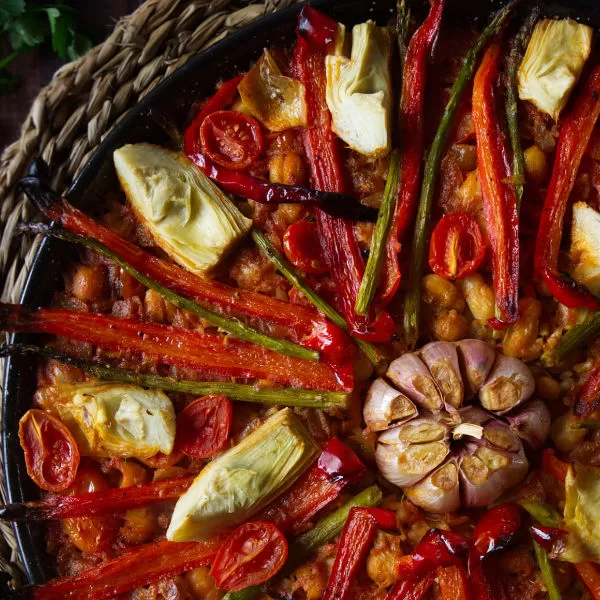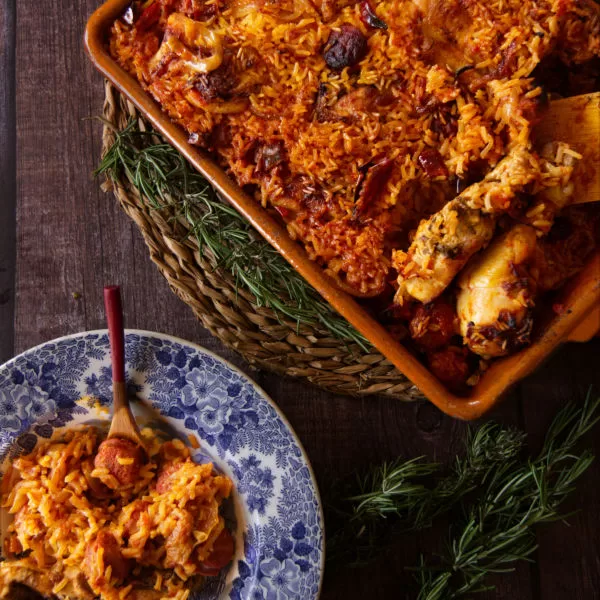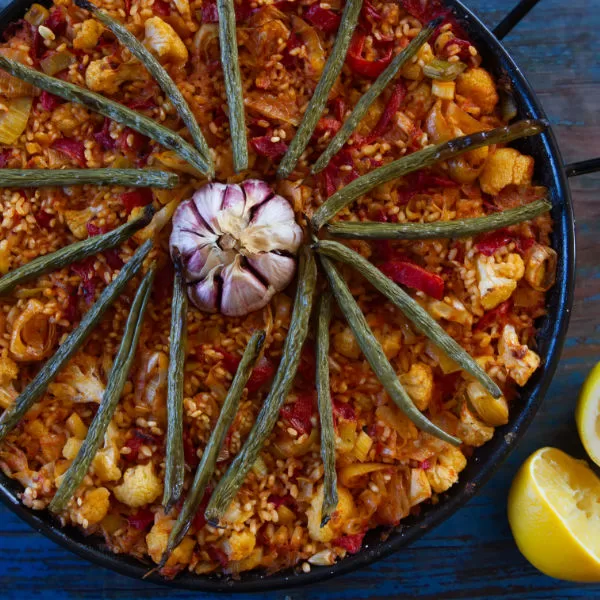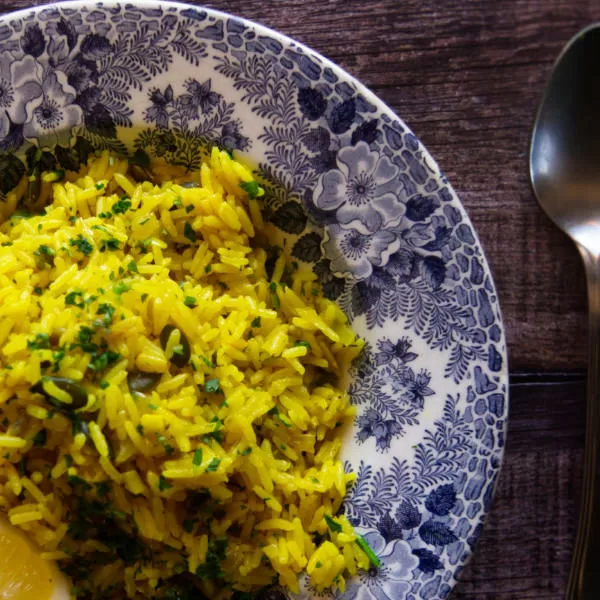Paella and Rice Recipes
Discover our fantastic paella and rice recipes from all over Spain, complete with step-by-step recipe instructions so you can make them at home! We’ve also provided some cooking tips, what equipment you’ll need to make the perfect paella, plus some spacial paella ingredients you won’t want to miss!
Sheet Pan Chicken Chorizo and Rice
Oven-Baked Rice | 1 hr recipe
Arroz al Horno
Spanish Oven-Baked Rice
Seafood Paella
Paella de Marisco
Arroz a Banda
Valencian Rice With Seafood
Paella Valenciana
Traditional | Valencian Paella
Super budget Spanish oven-baked rice
Vegan | Gluten-free | Soy Free
Vegan Arroz al Horno
Oven-Baked Rice | Vegan
Spicy Chicken, chorizo, and rice
Tasty & filling | Made in 1 hour
Oven-Baked Rice with Cauliflower
Vegan | Super Healthy Recipe
Mediterranean Yellow Rice
Vegan, Healthy
Orchard Paella
Paella huertana | Vegetarian Option
This post may contain Affiliate links for products that we use and love.
The great paella survey
Locals fed up with the many culinary crimes made upon their humble dish have laid down the law of making the ultimate Paella Valenciana recipe. They even went to the extremes and conducted a survey to pinpoint the exact appropriation of the authentic Paella Valenciana recipe.
The study concluded that the ingredients needed to make the ultimate Paella Valenciana are: rice, water, olive oil, salt, saffron, tomato, flat green beans, lima beans, chicken, and rabbit.
If you’re disappointed not to see any seafood make the list, don’t worry, we’ve got an awesome seafood paella recipe right here!
Traditional paella
The traditional paella (paella Valenciano) remains hugely popular throughout the Valencian region, and throughout greater Spain. There are also quite a few varieties and flavors of paella to sample and they are only increasing as chefs experiment more with the dish.
Perhaps one of the most popular paellas on the international food circuit is the paella de marisco (seafood paella). It’s made using the same technique as a traditional paella but uses a mixture of fresh seafood instead of meat and game ingredients.
Arroz ‘vs’ paella dishes
If you’re ever visiting the Mediterranean coastal region in or around Valencia, you’ll find hundreds of seaside restaurants offering seafood paella, and other rice (arroz in Spanish) dishes that carry the arroz ‘title’.
While these dishes are pretty much made using the same technique as a paella (and come served in the same paella pan) they do not share the ‘paella’ namesake. Some examples include Arròs abanda and Arròs negre.
Do I need any special equipment to make a paella at home?
Making paella at home doesn’t require any overly specialized equipment. However, a few items will make the process easier and ensure a more authentic result. Here are the essential pieces of equipment you’ll need:
- Paella Pan: The most critical piece of equipment is a Paella pan, also known as a “paellera.” These pans are wide, shallow, and have two handles. They are specifically designed to spread the rice out in a thin layer, allowing it to cook evenly.
- Heat Source: Paella is traditionally cooked over an open flame or on a grill, although Most prefer to use a paella gas ring. You can also use a stovetop. If using an open flame or grill, ensure that the pan is stable and evenly heated.
- Wooden Spoon or Spatula: A wooden spoon or Paella spoon/spatula is ideal for gently stirring the paella as it cooks, especially when adding the rice and arranging the ingredients.
- Cutting Board and Knife: You’ll need these for preparing your ingredients, such as chopping vegetables and cutting meat or seafood.
- Measuring Utensils: To get the right rice-to-liquid ratio, measuring cups and spoons will come in handy.
- Bomba rice: Spanish Bomba rice is highly recommended when looking to make an authentic paella recipe.
Optional, but highly recommended:
- Saffron: This is a key ingredient in traditional paella, providing its distinct flavor and golden color. Saffron is definitely worth using and can be easily purchased online.
- Paella Burner: If you plan to cook paella outdoors over an open flame, a paella burner will provide a more even distribution of heat, making the cooking process easier.
- Ñoras – Dried Ñora Peppers are a pepper from the bell variety. They are usually sold ground or flaked and add a delicious smoky flavor to the paella. Don’t worry, Ñora peppers are not spicy.
- Paella burner tripod stand : If using a paella burner, a tripod stand can offer stability and convenience.
- Chicken Stock: While you can use water for cooking paella, using chicken or seafood stock will add more flavor to the dish.
Remember that the essence of paella is about using fresh, quality ingredients and allowing the flavors to shine through. With the right ingredients and a paella pan, you can achieve delicious and authentic paella at home!
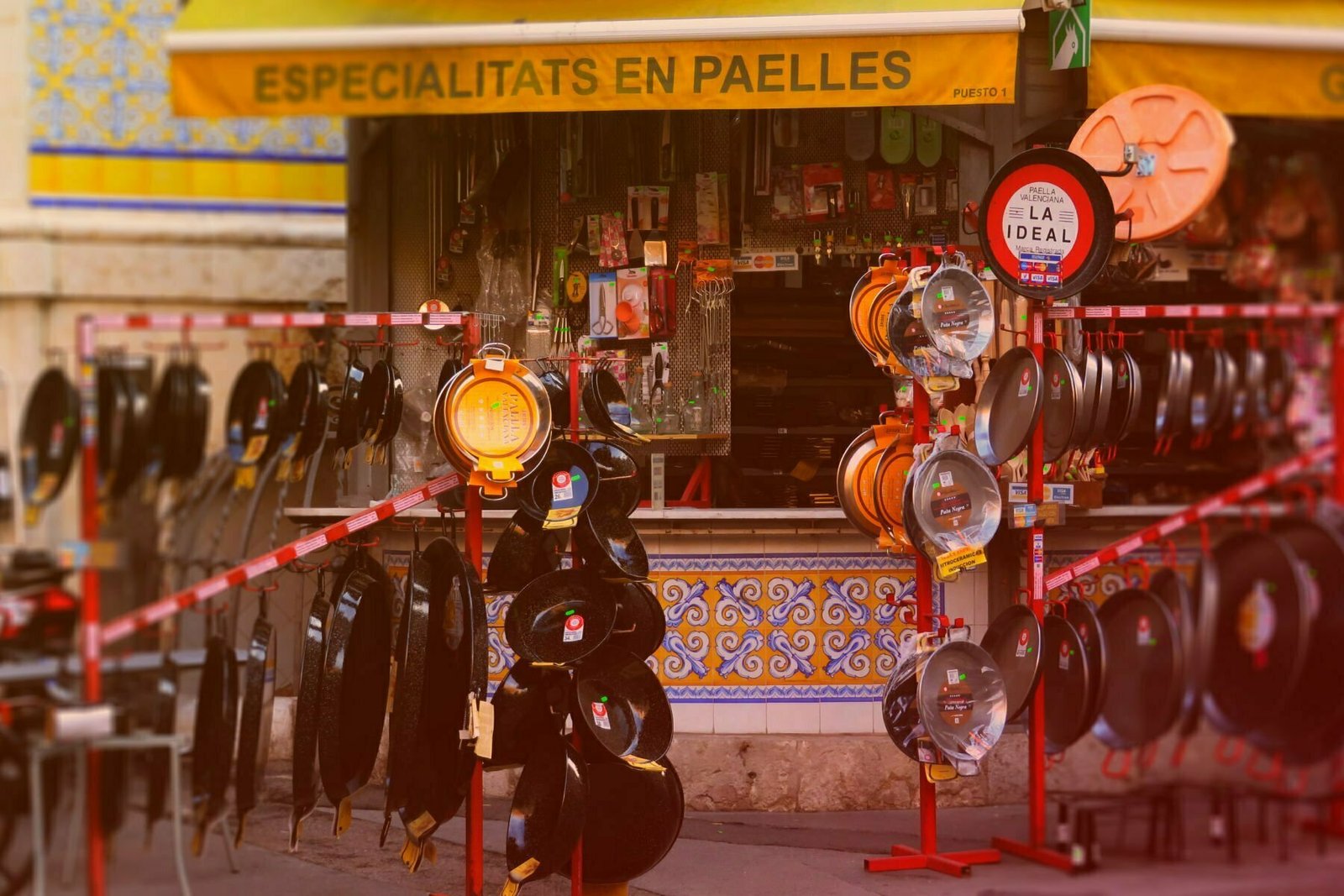
Why use a paella pan
The size of the pan is also very important. Most paellas are made with a thickness of around 2 grains of rice (around ¼ inch), so to feed 4 people, you’ll need a pan around 50cm (20 inches) in diameter. You also need a heat source that can distribute the heat to the entire pan so that rules out most gas stove tops.
If you’re serious about making the perfect paella, invest in a traditional steel paella pan and a gas ring to suit the pan size you have. Not only will it make life easier to cook paella, but you’ll also impress all the Spanish folk you know!
What size pan do I need to make Paella Valencia?
Of curse, this depends on how many you’re feeding. Paella Valencia is laid out over the pan so that it is only around 5-6mm thick (1 grain of rice high), so you’ll need at least a 12-inch (30cm) pan for 2-3 people.
Here’s a paella pan size guide:
- 4 people : 22-inch (56cm) pan
- 6 people: 30-inch (76cm) pan
- 8 people: 36-inch (91cm) pan
- 10 people: 44-inch (111cm) pan
Stainless Steel or Enamel Paella Pans: Which is Better?
Both are good and effectively do the same thing. Both transfer heat in much the same way, but which is better?
There are two camps dividing opinion, Here are the cold hard facts:
✅A 12-inch/30cm Machika Enamel Paella Pan costs USD$19.99 on Amazon
❌A 12-inch/30cm Machika Stainless Steel Paella Pan costs USD$59.99 on Amazon
✅Enamel pans are non-stick
❌Stainless steel pans are not considered non-stick
❌Enamel pans are not dishwasher safe
✅Stainless steel pans are also dishwasher safe
✅Enamel pans offer excellent heat conduction
✅Stainless steel pans offer great heat conduction
❌Enamel pans can retain heat, however, they are not as effective in achieving the perfect socarrat.
✅Stainless steel pans are considered better at retaining heat, which is important for achieving the coveted “socarrat” (caramelized rice crust) in paella and other Valencian rice dishes.
✅Enamel paella pans are suitable for conventional stove-tops, grills, paella burners, open fire, and domestic ovens.
✅Stainless Steel pans are suitable for conventional stove-tops, grills, paella burners, open fire, and domestic ovens.
❌Enamel paella pans are not suitable for induction stoves.
❌Stainless steel paella pans are not suitable for induction stoves.
✅Enameled pans are rust proof
❌Stainless steel pans require oiling after use to prevent rust and corrosion.
✅Enamel pans are easier to clean and resistant to staining (no oiling required after use).
❌Stainless steel pans may scratch if cleaned with steel wool or a wire scrubbing brush. This may cause rust or corrosion spots. T is recommended to oil your stainless steel pan with olive oil or vegetable oil after use.
In conclusion, both stainless steel and enamel paella pans have their merits. If you prioritize durability, heat retention, and even cooking, stainless steel might be the better choice. On the other hand, if you value a non-stick surface and ease of cleaning, an enamel-coated pan might be more suitable.
Ultimately, your personal cooking style and preferences will play a significant role in making the decision. P.S. We went with an Enamel pan!
Best rice to make paella
Rice is also something that should be carefully considered when making paella as not just any rice will work. The best rice to use is Spanish Bomba rice which is traditionally grown throughout the Valencia region of Spain. It’s exported pretty much everywhere so ask your local Spanish grocery store.
Spanish bomba rice works so well as it is a special strain of short-grain rice that absorbs 30% more liquid than other rice varieties yet remains firm.
If you can’t find Spanish Bomba rice, then you can use the next best thing, arborio rice. Whatever you do, do not use long-grain rice, basmati rice, or any other rice variety. You will end up with rice porridge and your paella will lack the flavor it deserves!

